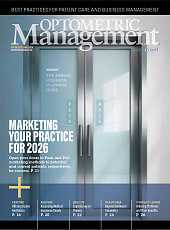IN SPECIALTY CONTACT LENS prescribing, eyecare practitioners often need adjunct therapies that might improve contact lens tolerance in the presence of corneal disease. One of those procedures is corneal cross-linking with riboflavin (CXL).
When practitioners see patients who have keratoconus or ectasia after corneal refractive surgery, they invariably feel the need to prevent progressive corneal distortion by referring a patient for CXL or performing it themselves. CXL has been considered a standard of care since the global Delphi panel on keratoconus and ectatic diseases released its findings in 2015 (Gomes et al, 2015).
Since those findings were released, the U.S. Food and Drug Administration (FDA) has approved one procedure, one type of light source, and one type of riboflavin; others are under investigation. Since CXL is now the standard of care and is an FDA-approved procedure, it is important to know the requirements for referring a patient for CXL (Glaukos).
The main barrier to patient referral for CXL is the retail politics of getting insurance reimbursement for the procedure. Most payors will cover a procedure only if it is medically necessary.
The current definition of “medical necessity” or “reasonable and necessary” is found in the Centers for Medicare & Medicaid Services (CMS) Pub. 100-08, ch. 13, § 13.5.4 definition of “reasonable and necessary.” The procedure has to be safe and effective; with some exceptions, not experimental or investigational; appropriate as to duration and frequency; furnished in accordance with accepted standards of medical practice for the diagnosis or treatment of the patient’s condition or to improve the function of a malformed body member; furnished in an appropriate setting by qualified personnel; meets, but does not exceed, the patient’s needs; and is at least as beneficial as an existing and available medically appropriate alternative (US Government Publishing Office, 2021).
Further, many payors have additional criteria for establishing medical necessity for CXL. They are generally the same as the Anthem Blue Cross UM Guidelines. Those guidelines require documentation of progress, which is defined as a diagnosis of keratoconus based on keratometry and corneal mapping; whether any of the following changes have occurred within 24 months: an increase of 1 D or more in the steepest keratometry measurement; or an increase of 1 D or more in manifest cylinder; or an increase of 0.50 D or more in manifest refraction spherical equivalent. The patient must be 14 years or older; and the corrected distance visual acuity is worse than 20/20 with properly fitted spectacles or contact lenses; and the corneal thickness is 300 microns or more; and there is no history of corneal or systemic disease that would interfere with healing after the procedure, such as chemical injury or delayed epithelial healing in the past (Anthem, 2024; United Healthcare, 2024).
A recent entry on EyeWiki states that a minimum of 400 microns of corneal thickness is required. Further, corneal scarring and severe ocular surface disease, or prior herpetic infection or current infection, are contraindications (American Academy of Ophthalmology, 2025).
So, before referring a patient for CXL, get your ducks in a row. Have a firm diagnosis, preferably based on topography. Next, rule out any of the referenced contraindications for performing CXL. Then, provide records to the surgeon that prove the progression according to the guidelines. Finally, tell the patient that there might be some coverage gaps based on their insurance plan, and have them check with their carrier (Blue Cross/Blue Shield/Blue Care Network).
References
1. Gomes JAP, Tan D, Rapuano CJ, et al; Group of Panelists for the Global Delphi Panel of Keratoconus and Ectatic Diseases. Global consensus on keratoconus and ectactic diseases. Cornea. 2015;34(4):359-369. doi: 10.1097/ICO.0000000000000408
2. Glaukos. Lead the Way With iLink. Accessed Feb. 11, 2025. glaukos.com/cornea/solutions/ilink/fda-approved-corneal-cross-linking
3. US Government Publishing Office. Medicare Program; Medicare Coverage of Innovative Technology (MCIT) and Definition of “Reasonable and Necessary.” Federal Register. 2021.86(9). Accessed Feb. 11, 2025. govinfo.gov/content/pkg/FR-2021-01-14/pdf/2021-00707.pdf
4. Anthem. Clinical UM Guideline: Corneal Collagen Cross-Linking. Published Jan. 30, 2024. Reviewed Nov. 14, 2024. Accessed Feb. 11, 2025.anthem.com/dam/medpolicies/abc/active/guidelines/gl_pw_e000230.html
5. United Healthcare. Corneal Collagen Cross-Linking. Published Nov. 1, 2024. Accessed Feb. 11, 2025. uhcprovider.com/content/dam/provider/docs/public/policies/umr/corneal-collagen-cross-linking-umr.pdf
6. American Academy of Ophthalmology. EyeWiki: Corneal Cross-Linking. Published Jan. 26, 2025. Accessed Feb. 11, 2205. eyewiki.org/Corneal_Cross-Linking



